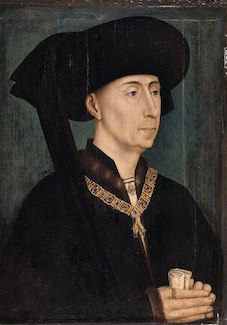Product Description
Cartier “Order of the Golden Fleece” pendant necklace with an 18K gold and silver ram, matching Cartier 18K gold chain, signed, c. 1970’s



Cartier “Order of the Golden Fleece” pendant necklace with an 18K gold and silver ram, matching Cartier 18K gold chain, signed, c. 1970’s
JEAN MARION GATES HALL (1911-2001) USA
Napa Valley 1940
Oil on canvas, original wood frame
Signed: with her monogram initials JGH (lower right)
Marked on back: Jean Gates Hall, June 18, 1940, Napa Valley
Canvas: H: 14″ x W: 17 1/4″
Framed: H: 17 1/2″ x W: 20 1/2″
Price: $4,250
Born in Memphis, TN on May 19, 1911. Jean Gates studied at the Cummings School of Art in Des Moines. At age 14 she moved to Los Angeles with her family. There she continued at the Chouinard Art School while working for Warner Bros, Walt Disney, and Mintz Studios. Upon moving to San Francisco, she married writer James D. Hall in 1938. Her illustrations were used in her husband’s children’s books. She established a studio in the “Monkey Block” (now the Transamerica Pyramid) and was active in the local art scene. She later earned her B.A. degree at San Jose State University (1955) and M.A. degree at UC Davis (1966). Working in oil and watercolor, her painting style and subject matter evolved with the years from descriptive realism to linear pictures, and finally an entirely new medium called Magpage. Mrs. Hall was a resident of Oakland in the 1980s and died in Cedar Ridge, CA on June 23, 2001.
Exhibitions: Iowa State Fair, 1926; California State Fair, 1937; GGIE, 1939; Paul Elder Gallery (SF), 1939 (solo); NMAA, 1941; SFMA, 1942 (solo); De Young Museum, 1944 (solo); California WC Society, 1945-53; UC Davis, 1946, 1965 (solos); Kingsley Art Club (Sacramento), 1965.
The well known Beverly Hills jeweler, William Ruser, started his career at the firm of Trabert & Hoeffer-Mauboussin in Atlantic City New Jersey, before being transferred to manage their Los Angeles location in the 1930’s. In 1947, he and his wife opened their eponymous boutique on Rodeo drive. While keeping traditional diamond and precious gemstone merchandise in stock, the Rusers’ specialty was baroque, freshwater pearl jewelry. In the 1930’s, Ruser had bought several shoeboxes full of these oddly shaped, American pearls from a button manufacturer. Freshwater pearls had been relatively unpopular at the time. Though Art Nouveau jewelers used them liberally to embellish their pieces, jewelers in the 1920 and 30’s did not follow suit. In the late 1940’s and throughout the 1950’s, Ruser helped to change this. In the vanguard, along with Verdura and Seaman Schepps, the Rusers created swans, hummingbirds, poodles, skunks, as well as playful cherubs with freshwater pearl accents. Throughout the 1950’s and 60’s, business boomed and Hollywood starlets proudly wore his figural pieces both on and off screen. In 1969, Ruser closed up shop, selling its location to Van Cleef & Arpels.
